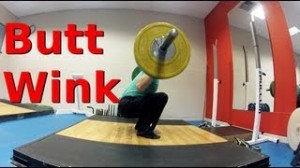Butt Winking? One Solution Is To Open Up The Back Of The Hip
The butt-wink. It is a common phenomenon. In fact, I would say that it happens far more often than not. Some people think it is ok. Others say it is dangerous (I think it can be dangerous but not all butt-winks are butt-winks!). But at the end of the day. the butt-wink is inefficient - it is a joint that is moving when it doesn't have to therefore it is a source of a loss of torque.
Why Does A Butt-Wink Happen?
- Simply put, you need to keep your centre-of-gravity over your base of support. A butt wink occurs because you are trying to keep your balance!
- In today's post, I am only focusing on a tight posterior hip. There are many reasons why a Butt-Wink occurs.
What Does a Tight Hip Look Like?
- You will have limited internal rotation on assessment.
- When you squat, your hips start to tuck under into the butt-wink BEFORE you run out of ankle or knee flexibility
How Do I Help It?
- STOP trying to get MORE external rotation - you need MORE INTERNAL ROTATION!!
- Pigeon stretch, figure 4 stretch etc is good for external rotation but you also need internal rotation
- Having a balance of internal and external rotation will allow you room in the back of the hip - this allows the ball to slide back in the socket of the hip which keeps your hip stable and all your muscles happy!
- Think about the back of your hip being a baseball mitt and the ball is the end of your leg. Put the ball of the hip in the socket.
- A ball in the back of the hip in the following position helps...knees together, feet apart, target the back of the hip.
- You can roll onto the side a bit, just keep the knees inside the feet and you should be fine.
- Doing this helps to open up the back of the hip to allow the ball to access the deep hip external rotators.
- Having the knees bent up as far as you can mimics the depth you need in the squat.
- Try to keep your back flat to avoid excessively stretching it...but it isn't absolutely necessary...aim for the stretch in the back of the hip and strengthen your back with something like a Pendlay row.
Summary:
Try those tips and see how you go. There are plenty of other ways to help release the hips and get more internal rotation...don't forget to test/retest and only do one side at a time for 30secs each time 🙂



So I was told by a trainer that I ‘tuck’ in my squats so presuming this is what she means. She was trying to encourage me to only squat to parallel – my response was to say ‘how about I lose the weights, do bodyweight only and learn to do full-depth ones properly’…your response, A-Lo?
Erika! Nice to hear from you 🙂
For the case above, you are both right.
It is good to keep form as low as you can go and stand it up again – so going to parallel might be right for you…
Dropping the weight and learning how to control your position and improve your hip flexibility and control is also a good thing to do.
So you are both right 😉
How was that for diplomacy? It also happens to be the right answer 😉 hahahaha
Great snippet Antony!
Far too often people advocate that tight hammys are the culprit, this is fantastic.
What are your thought’s on the butt wink in relation to poor lumbo-pelvic control. Personally I’ve had good results with “deep abdominal” bracing prior the lift, do you perceive this to be an inefficient movement strategy (based on your other “bracing” videos) even though it helps to eliminate my cheeky wink?
Thanks
Thabks louis. If your butt wink is from a motor control problem (poor coordination of your deep abdominal muscles), then the bracing you are doing is likely to be an intermediary step. The fact that you can concentrate on somethibg and change the pattern says to me that you should be able to get the same results without the brace.
Let that mess with your head for a wee while…just go try it and film it. It is all about results